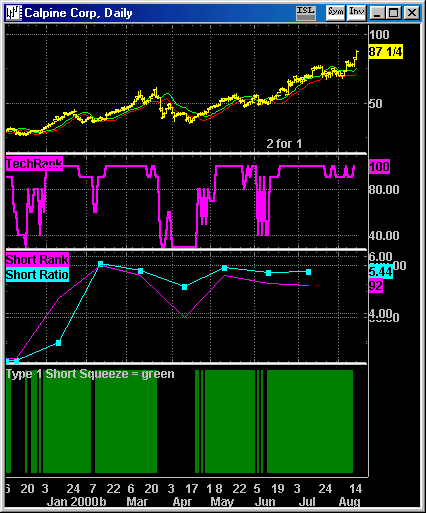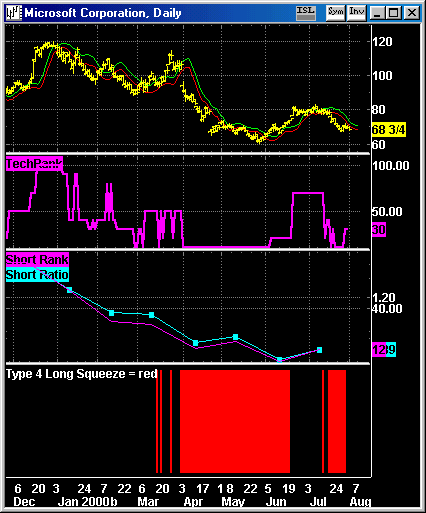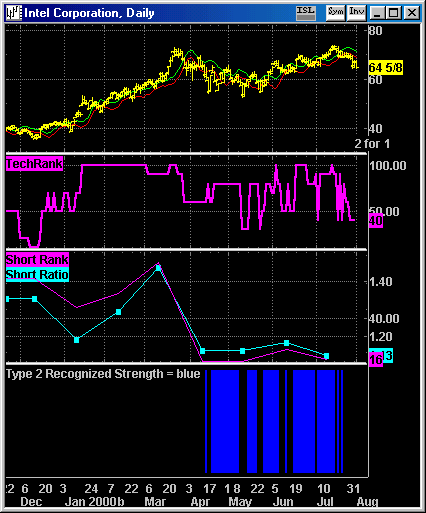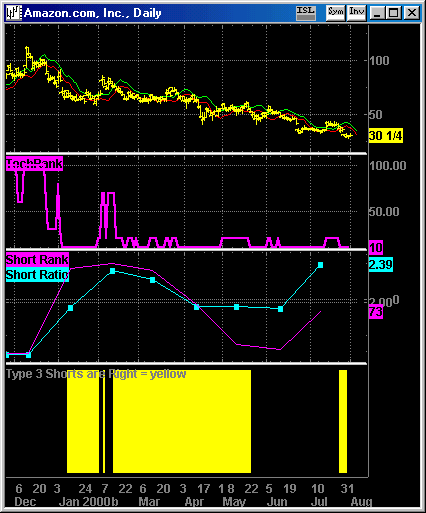|
STRATEGIES
Type Classifications
Use the Erlanger Type Classifications to Buy, Hold, Sell and Sell
Short stocks!
Just what are the Erlanger Type Classifications? The are extra
rankings designed to pinpoint four patterns:
Type 1) Short Squeezes -
we like to buy these. These are stocks whose relative strength is
so strong that their Erlanger Technical Rank is above 70. This is
not all, however. In addition to relative strength, in order to
qualify as a short squeeze, there must be a lot of short selling.
So a Type 1 short squeeze must have an Erlanger Short Rank above
50. The following chart shows CPN with it's Technical and Short
Ranks, it's Short Interest Ratio, and a color study showing GREEN
when the numbers indicated a Type 1 "Short Squeeze" underway:

Type 4) Long Squeezes - we
like to sell short these. These are stocks whose relative strength
is so weak that their Erlanger Technical Rank is below 30. This
is not all, however. In addition to a lack of relative strength,
in order to qualify as a long squeeze, there must be very little
short selling. We interpret this as a sign of extremely bullish
expectations. So a Type 4 long squeeze must have an Erlanger Short
Rank below 30. The following chart shows MSFT with it's Technical
and Short Ranks, it's Short Interest Ratio, and a color study showing
RED
when the numbers indicated a Type 4 "Long Squeeze" underway:

Type 2) Recognized Strength
- we like to hold these. These are stocks whose
relative strength is strong but the short selling is light. In other
words, the trend of strength is recognized and most expect it to
continue - so they prevailing sentiment is to not sell short. While
we hold these issues, we also view them as higher risk exactly because
the strength is recognized - the buying has largely already taken
place. Moreover, Type 2s often turn into Type 4s at some point,
so a strategy of getting ready to sell is appropriate, waiting for
signs of relative weakness to trigger the sell. A Type 2 pattern
of recognized strength must have an Erlanger Short Rank below 30.
The following chart shows INTC with it's Technical and Short Ranks,
it's Short Interest Ratio, and a color study showing BLUE
when the numbers indicated a Type 2 "Recognized Strength"
pattern:

Type 3) Shorts Are Right -
we like to avoid these. These are stocks whose
relative strength is weak but the short selling is heavy. In other
words, the trend of weakness is recognized and most expect declining
prices to continue - so the shorts are correct. While we avoid these
issues, we also view them as a potential precursor to a turnaround-
the selling has largely already taken place. Type 3s often turn
into Type 1s at some point, so a strategy of observance appropriate,
waiting for signs of relative strength to trigger a buy. However,
if a stock goes from a Type 3 to a Type 4, it is in real trouble
- this means the stock was unable to rise even after the shorts
covered (closed out their short positions by buying back the shares
they sold short). In other words, the shorts took their profits...
usually too soon. A Type 3 pattern must have an Erlanger Short Rank
above 50. The following chart shows AMZN with it's Technical and
Short Ranks, it's Short Interest Ratio, and a color study showing
YELLOW
when the numbers indicated a Type 3 "Shorts Are Right"
pattern:

|





